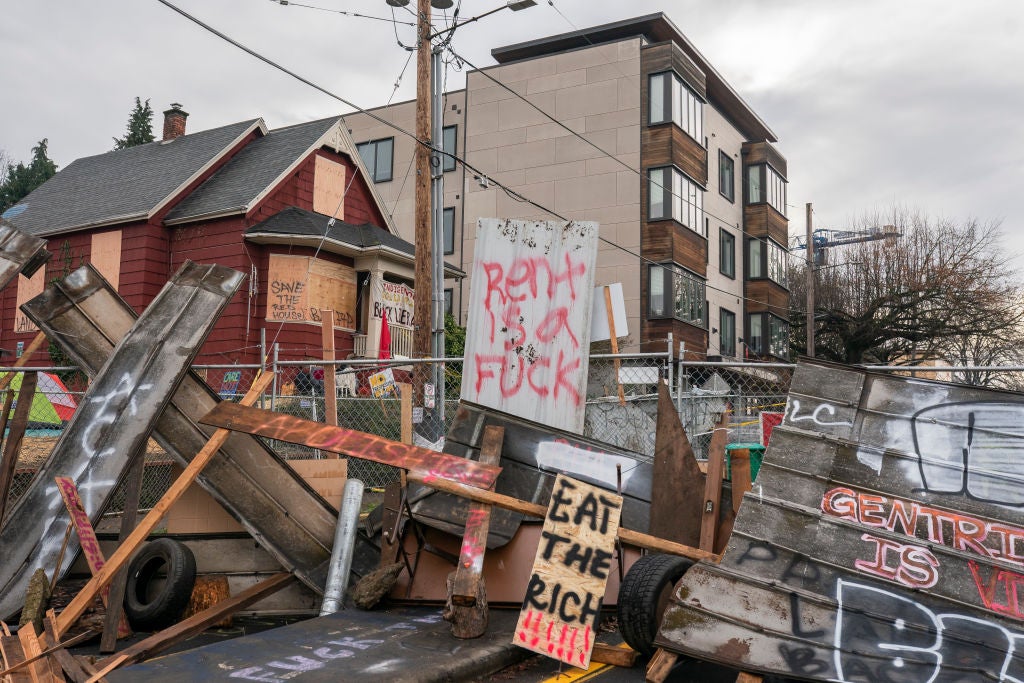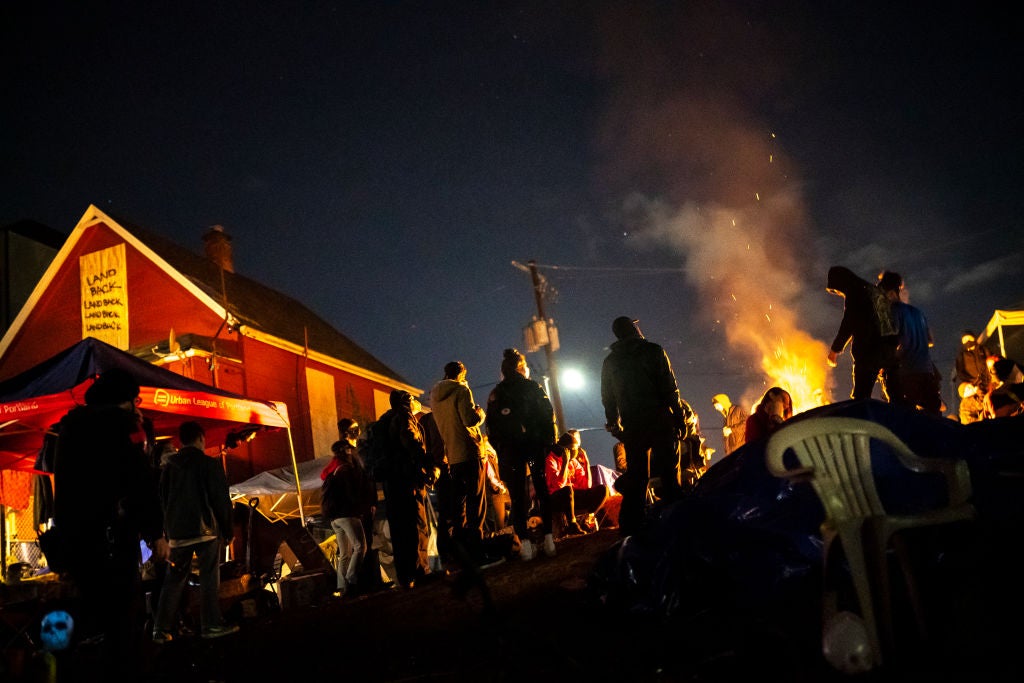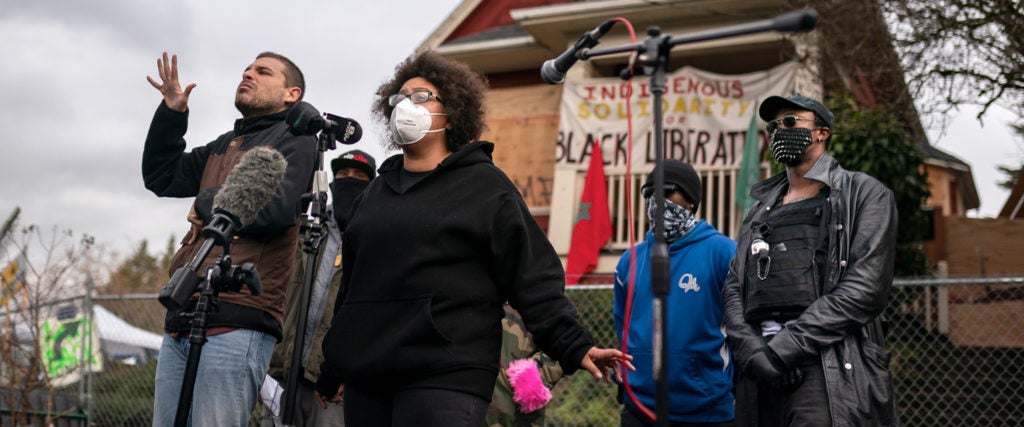The barricade was born from a fence that was torn down. It wasn’t much to begin with — just a bit of chain-link and a few lazy strings of barbed wire. But the law enforcement who erected it outside the ruddly little house at 4406 N. Mississippi Ave., just 10 minutes north of downtown Portland, Oregon, didn’t plan for the fence to be used against them.
They had arrived in the dawn light on December 8th, ready to sweep the house and board it up. Awaiting them was a handful of people, just about a dozen drowsy bodies, occupying the property in defense of the Kinneys, a Black and indigenous family with three generations of history in the home.

The Kinneys weren’t there, and that was fine by the Multnomah County sheriffs and Portland police officers who stormed the house. They arrested seven people, snatched up an armful of firearms owned legally by the Kinneys, and busted up whatever they could — the kitchen, the windows, the bathrooms, the plumbing, a makeshift outdoor food area used by protesters — in an attempt to stop what they viewed as squatting. And they figured the commotion and the fence would send a clear and convincing message: The months-long protest against the eviction of the Kinneys was over.
With that done, law enforcement departed — then the neighborhood took note. A trickle of curious people turned into a wave of attention as a few hands ripped a gap into the fence and others began spreading the word, rapidly attracting a network of dedicated, ferocious local activists, as well as more police. A little before 9 a.m., the tension reached its apex.
We are at “fuck the fence”
O’clock pic.twitter.com/LUs4lg0XUl— Melissa “Claudio” Lewis (@Claudio_Report) December 8, 2020
“All of a sudden, there was just a palpable rage that I haven’t felt in a crowd since the occupation by the Feds, where it just came to a head and burst,” Melissa Lewis, a protest videographer and journalist in Portland, tells me. “People were in their pajamas, wielding breakfast items. They charged at the cops, banging on patrol cars, breaking windows. Someone sprayed a fire extinguisher at them. And as soon as the cops were chased off that second time, people just spontaneously began building barriers.”
Over the course of hours, the chain-link fence was moved to the street and fortified with all manner of bulky objects, donated and scavenged and perhaps “disappeared” from nearby construction sites. Young faces in black bloc and cheap flak jackets began patrolling the boundary, peering for police. Others gathered to take stock of supplies, plan support duties and discuss strategy for the days ahead. As the energy began to dissipate, local activist Ragina Gray took to a bullhorn to implore the crowd to stay.
“You cannot leave. You’ve been waiting for direct action all your life, this is it. Occupy this space for Afro-Indigenous people. This cannot happen any longer. We have to rise and fight this every time they try. No more displacement. No more!” she declared with hoarse rage. “You have to stand and fight against fascism every opportunity you have. You’re fighting for Black liberation, and you’re fighting for yours, too!”
Protesters in Portland are occupying space around Mississippi Avenue following police returning to the “Red House,” where a local family is being evicted pic.twitter.com/C4b4JRhN7T
— Zane Sparling (@PDXzane) December 8, 2020
By the next morning, the three-block stretch on Mississippi Avenue outside of the home was completely fortified, with traffic being redirected and police nowhere in sight. And for the next six days, a diverse group occupied this unlikely haven as a narrative battle around the Kinney family raged in the public eye.
The Red House is a much more complicated story than that of just a Black and Indigenous family that was surprised by the threat of an eviction as winter neared. The threads of this tale unwound over the course of a decade, and it illustrates how early mistakes with predatory loans led the Kinney family into a corner — a corner where they decided to confront and fight the state instead of playing by its rules and losing out in the process.
In doing so, the Kinneys brought together a fierce coalition of community organizers, anarchists and anti-fascist protesters. What resulted is an unstable but fascinating blueprint for what militant eviction defense can look like in America when mutual aid meets revolutionary tactics, all under a simple slogan: Housing is a human right.
* * * * *
The tale of the Red House stretches back some 65 years, when William and Pauline Kinney collected their life savings and bought a house in North Portland with cash — the banks wouldn’t offer them a loan thanks to racist redlining. They bought the home in a time of great change for the neighborhood — the devastating 1948 Vanport flood triggered a wave of Black resettlement to Albina, which in turn led to mass white flight.
By the 1960s, Albina was home to a huge majority of Portland’s Black population; the Kinneys even rented their home out to Black families for a time. In 1983, William Kinney Jr. and his wife, Julie Metcalf, a Native woman from the Upper Skagit Tribe of Washington, took over the home and raised a family of three kids there.
Things have changed dramatically since: Harmful home-lending practices, divestment from the state and rising unemployment rates in past decades triggered a cycle of “urban blight” and decreasing homeownership. As gentrifying forces seeped in, the once-Black neighborhood transformed from an enclave of generational wealth into a place sucked clean of it, replaced instead by pricey apartment complexes, boutique businesses and increasingly whiter families.
The Kinneys claim the Red House is one of the few Black-owned properties in the neighborhood now, and an especially lucrative one as it sits alongside an unused plot of land — perfect for developing a much bigger building. But the struggle of the Kinneys stems from a tragedy in 2002, when their 17-year-old son William Kinney III hit and killed an elderly driver after accidentally running a stop sign. The Kinneys mortgaged their home for a $96,000 loan to cover the legal fees and future costs.

And despite paying faithfully for 13 years, something went awry in 2016, when the loan switched hands to a new mortgage company. The Kinneys say that both firms were asking for money, leading the family to stop payments while it figured out what was going on. At some point in 2017, the family decided to battle the validity of the loan altogether; over the course of 2018, back-and-forths with their new creditor began to deteriorate, with William Kinney III (now going by the name William X Nietzsche) increasingly arguing for the family’s sovereign right to the property. In June 2018, the Red House received a notice: Pay $19,150 to reinstate the loan, or the full amount of $112,339. The Kinneys ignored it.
On October 23, 2018, the home was sold to a real-estate developer for $260,000. While the funds from that sale, minus the outstanding loans, should have been funneled back to the Kinney family, they didn’t budge from the home itself. By now, it was more than a fight over missed payments; the Kinneys claimed a history of racist, fraudulent and otherwise unethical financial machinations — ranging from incredibly high interest rates to inflated fees and sketchy disability coverage plans — had put them down an irreversible path. Instead of making payments, William Nietzsche filed legal challenges, often nonsensical, throughout 2019. Most recently, he requested consideration from the U.S. Supreme Court.
The Kinneys didn’t respond to multiple requests for comment, but reading their public statements, the core of their rejection of the foreclosure becomes clear: They see inherent evil in sticking one of the last Black homeowner families in their neighborhood in a cycle of debt, somehow leaving them with a higher balance than they started with after 13 years of payments. To them, it must have felt like a final straw for a court to authorize the eviction in 2020 despite a Portland moratorium on just that amid a pandemic.
“This isn’t a typical foreclosure case,” Kinney said in a news conference on December 11th. “This is a David and Goliath fight. We’re just a small family seeking to defend our house against big banks and developers. My parents were preyed upon by the same predatory practices that led to the 2008 financial crash. This has crossed the threshold to a crime against humanity.”
William Nietzche, a resident of N Mississippi Ave was served an eviction notice, 9am September 10th. His family has lived there since 1955. This is just a few of his words, I'm planning to follow the story further in days to come. If you've heard of recent evictions, let me know. pic.twitter.com/bUAxiTf66Q
— Brian Conley (@BaghdadBrian) September 11, 2020
The family was caught off guard when law enforcement showed up for that eviction on the morning of September 9th, armed with rifles and demanding the Kinneys leave the home within 30 minutes. But the incident gave the green light for the Kinney’s legal battle to become one of militant direct action — thanks to a social media blitz and the Pacific Northwest’s network of leftist activism, a small cadre of occupiers showed up and never really left.
The night of September 20th was effectively the coronation party for the Red House defense — there was music, dancing, a rap set from Portland activist Jadhi and a vape-pen-cum-smoke-machine to set the vibe. People shared food and discussed politics. As the days unfolded, it hardly mattered that wildfires blanketed the region in smoke; dedicated activists sat in their cars, remaining on guard for cops or any white supremacists who took issue with the Kinneys. When the smoke cleared, the tents and all-nighters resumed. The crackdown in December only made the rescue party swell in size, as more and more people arrived with supplies and an appetite for networking. The scene had more than a bit of absurdist humor to it; at one point, people speared marshmallows onto self-defense batons to roast over an open fire, and a guy in black bloc played the banjo to no one in particular. Activists did meet a number of agitators — Lewis, the journalist, tells me there were “a few drive-by macings” and an improvised explosive device that someone tossed from a car (“I yelled for us to hit the deck, but it was fine,” she deadpans).
@Jahdi_ just did a truly incredible set. I’ll try to post some more of it on the Insta. And then, it being Laurelhurst, a very nice park ranger told the party that neighbors had called the cops with a noise complaint. At 8 pm.
So now the dance party is headed to N Mississippi. pic.twitter.com/aYqyv9jfHp
— 45th parallel absurdist brigade (@45thabsurdist) September 21, 2020
An enterprising individual has decided to use their vape pen as a smoke machine. pic.twitter.com/M3MOJ4O0TF
— 45th parallel absurdist brigade (@45thabsurdist) September 21, 2020
Anti fascist activists use their “stockpiles” of weapons (in this case three asp batons) to roast marshmallows for s’mores pic.twitter.com/3dOhQPupiR
— Melissa “Claudio” Lewis (@Claudio_Report) December 10, 2020
Posted with permission: anti fascist protesters gather around campfires. At this specific guard post, an activist in black bloc plays the banjo. “Level four plates don’t work with the banjo,”they joke and unclip their plate carrier. pic.twitter.com/ywhODnI6Q7
— Melissa “Claudio” Lewis (@Claudio_Report) December 11, 2020
There was plenty of negative press: Some neighbors claimed that activists had intimidated them, while mainstream media outlets dug into the Kinney family members and their history of missed mortgage payments, seemingly challenging and discrediting the narrative the Red House had built. But for every death threat to the family, there were dollars being delivered digitally via a GoFundMe campaign to raise enough to buy the house back.
After five days of the barricaded occupation, Portland Mayor Ted Wheeler and Police Chief Chuck Lovell held a press conference on December 13th to announce that the city, developer and Kinney family had reached a “tentative agreement” to buy back the house, although it remains unclear exactly how that will unfold. Today, the Kinneys have raised nearly $315,000 for the cause — and with the agreement, the family announced that the barricade around their longtime home had to come down.
“This is a whole new level of progress, and the impacts are going to reverberate around the nation,” activist Mac Smiff, a prolific voice at the Red House action, told The Oregonian. “This isn’t like what we’ve seen before. It’s a negotiation and a win, and that’s something we’re just not used to.”
Seriously, if this deal holds, the Red House saga would be the biggest win we've seen since the Fed Wars, and I'd argue this is a much more substantial and definitive victory for the revolution.
The results of this will ripple across the nation.
— Enjoy This Moment ?? (@MacSmiff) December 13, 2020
But for some activists, the announcement came as a blow, not a victory. Some wanted to maintain the barricaded area as a political bargaining chip. Others merely viewed it as a critical attack on the power of the state and banks alike. But a Seattle CHOP this wouldn’t be; more than 100 people came together on the day of Wheeler’s announcement with drills, hammers and crowbars to remove the mass of plywood, plastic, fencing and steel on both sides of Mississippi Avenue. Others grabbed sponges and cleaner to scrub off graffiti and art from nearby businesses and public spaces.
the side of the @RHonMississippi eviction defense that the media isn’t reporting – defenders cleaning graffiti from a small business and leaving care packages with hand sanitizer and masks in their porch. pic.twitter.com/3AtZsPh3Jw
— prank sinatra (@yourantifagf) December 12, 2020
While the Red House movement had no titles or explicit leaders, it did have a clear rule: Listen to the Kinneys. And so, with a boom and a whisper behind closed doors, the saga is at rest for now. The unbarricaded occupation of the Red House continues, and the police have pledged to stay away. But more than anything, the frenzy around the Kinneys has become a vital reflection on the broader debate of who deserves to keep a home. Does it matter that they defaulted on a mortgage if their family and home is a testament to the discrimination and exploitation that Black and Indigenous people have faced in America? Will people defend a person’s right to shelter even if that person has a rap sheet? And can we allow the financial industry to continue as-is if we know the outcome is a disproportionate loss of Black and Indigenous wealth?
At least one group seems to have gotten the message: There’s a new occupation of a home in Seattle, with a cadre of activists ready for militant defense. The Red House is a perfect metaphor for the chaos and inequality of 2020 — but it’s also becoming a model for action to come.

